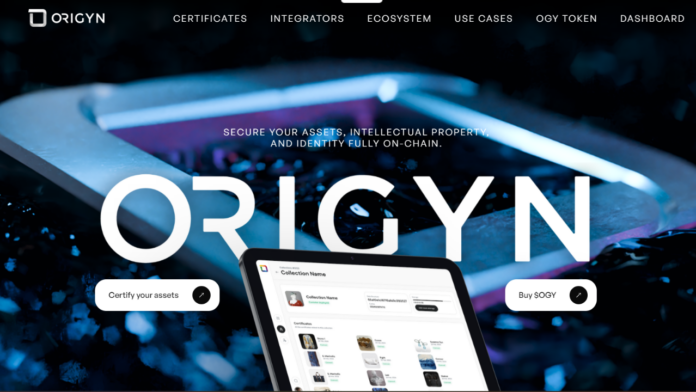ORIGYN has rolled out its redesigned website, and it’s far from your standard face-lift. This fresh take on their digital home aims to do something often missing in the on-chain certification world—cut through the clutter and help people actually understand what’s going on. At first glance, it’s sleeker, sharper, and faster. But beyond the aesthetics, the real story is function, clarity, and accessibility. It’s now easier than ever to see how tokenising real-world assets works, what it costs, and where the protocol is heading next.
Founded to bridge real-world assets with decentralised certification, ORIGYN operates on a principle that’s simple in theory but often tangled in practice—bringing truth, transparency, and verifiability to the ownership of things that exist outside of cyberspace. Whether it’s a Picasso painting, a Cartier bracelet, or a brick of gold, ORIGYN aims to verify its authenticity and record it immutably on-chain.
But let’s be honest—blockchain doesn’t have a UX reputation for being welcoming. Too often, users find themselves lost in a jungle of jargon and tech abstractions. ORIGYN appears to have clocked that reality and responded accordingly. The new website is a direct response to that problem. The goal? Strip back the unnecessary and let the protocol speak clearly through design and functionality.
Right from the homepage, the refreshed layout moves quickly to address user needs. Whether you’re an individual curious about certifying a single asset or a company looking to digitise an entire inventory, the journey is mapped out with clean logic. The site doesn’t assume technical literacy. It shows, rather than tells, using real examples, live metrics, and walkthroughs that make the process feel less like a lecture and more like a guided tour.
The ‘Use Cases’ section is a standout. It highlights exactly where and how ORIGYN’s tech is already active. From high-value art and collectible authentication to tokenised precious metals, the section showcases living proof that the protocol isn’t just theory—it’s already in action. You can see how assets are being fractionalised, verified, and tracked on-chain, and what that means for their market value, tradability, and provenance.
A new addition, the certification cost calculator, could be a game changer for many. It’s one thing to talk about accessibility, another to offer a transparent, self-serve tool that lets users see actual cost estimates. With just a few inputs, you get an immediate idea of what you’d spend to bring your asset into the certified digital fold. Whether you’re minting a single certificate or mapping out an enterprise-scale rollout, the numbers are right there—no gatekeeping, no hidden forms, no sales reps in your inbox.
ORIGYN has also made it clear that this redesign isn’t a one-off. The site now features a live roadmap that gives users a peek into the protocol’s pipeline. Expect integrations with standards like ICRC-7, public minting tools to expand access even further, and new global partnerships aimed at taking certified assets mainstream. The roadmap offers dates, targets, and milestones in a way that invites participation, not just passive observation.
To help users understand the current state of the protocol, there’s a newly embedded stats section. It’s not decorative—it’s informative. Key data like total certified assets, $OGY market cap, total value locked (TVL), and number of DAOs in the ecosystem are available at a glance. This makes it easier to track progress and see how the network is growing over time, with no need to open a block explorer or scroll through forums.
Karolina Głusek, President of the ORIGYN Foundation, summed up the intent behind the overhaul in plain terms. The focus was clarity. Certification, ownership, and digital provenance can all sound abstract, especially for people coming from traditional industries. The redesign wasn’t just a paint job—it was about making everything intuitive. From exploring how the technology works to understanding what it costs to participate, the updated site aims to give users the tools they need without sending them to Google every five minutes.
What stands out in the launch announcement is the tone—there’s no puffery, no convoluted claims. The message is direct: blockchain can solve real problems in real industries, and ORIGYN is focused on making that practical and usable, not just theoretically sound. By removing friction points, they’re inviting more people into the process—creators, collectors, institutions—without demanding a PhD in cryptography.
At a time when the conversation around real-world assets and on-chain ownership is heating up, ORIGYN’s move to simplify its front-facing experience feels timely. With major players entering the RWA space and institutional interest growing, tools that help demystify the process are likely to see growing demand. It’s one thing to build strong tech infrastructure, but quite another to make that infrastructure legible and friendly.
That accessibility is what gives ORIGYN a certain edge. It’s not positioning itself as exclusive or overly niche. The protocol is built for use across markets, from luxury to logistics. And now that the website reflects that diversity of application, the path from interest to engagement feels a bit shorter.
The directness of the messaging doesn’t come at the cost of technical depth, either. Users who want to dive into documentation, governance models, or tokenomics can do so via clear navigation and linked resources. The site lets different kinds of users—builders, buyers, verifiers, and investors—find their own entry points without being overwhelmed by information they don’t need right away.
Another interesting aspect is the feedback mechanism. ORIGYN is actively asking its community to explore the new site and share thoughts. That signal of co-creation aligns with its decentralised ethos and gives current and future users a role in shaping how the protocol grows. It’s one thing to publish a roadmap; it’s another to invite public commentary on it.
Ultimately, ORIGYN’s redesigned site feels like it was built for a wider audience, not just early adopters. It manages to bridge trust, utility, and openness—three words that get used often but rarely land in combination. The redesign doesn’t aim to dazzle. It aims to explain, simplify, and invite.
So whether you’re looking to digitise and certify something valuable, wondering what $OGY is doing in the market, or just keen to see what asset verification actually looks like on-chain, the new site is well worth a visit. It may just change the way you think about ownership, one click at a time.
Visit the site at: https://origyn.com
Feedback is welcome—they built it with you in mind.


